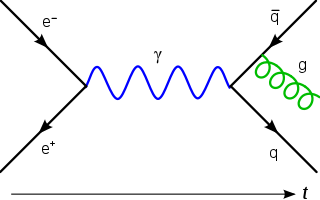
A gluon is a type of massless elementary particle that mediates the strong interaction between quarks, acting as the exchange particle for the interaction. Gluons are massless vector bosons, thereby having a spin of 1. Through the strong interaction, gluons bind quarks into groups according to quantum chromodynamics (QCD), forming hadrons such as protons and neutrons.

Omega baryons are a family of subatomic hadrons which are represented by the symbol
Ω
and are either charge neutral or have a +2, +1 or −1 elementary charge. Additionally, they contain no up or down quarks. Omega baryons containing top quarks are also not expected to be observed. This is because the Standard Model predicts the mean lifetime of top quarks to be roughly 5×10−25 s, which is about a twentieth of the timescale necessary for the strong interactions required for Hadronization, the process by which hadrons form from quarks and gluons.

In particle physics, annihilation is the process that occurs when a subatomic particle collides with its respective antiparticle to produce other particles, such as an electron colliding with a positron to produce two photons. The total energy and momentum of the initial pair are conserved in the process and distributed among a set of other particles in the final state. Antiparticles have exactly opposite additive quantum numbers from particles, so the sums of all quantum numbers of such an original pair are zero. Hence, any set of particles may be produced whose total quantum numbers are also zero as long as conservation of energy, conservation of momentum, and conservation of spin are obeyed.
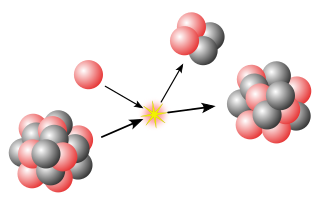
High-energy nuclear physics studies the behavior of nuclear matter in energy regimes typical of high-energy physics. The primary focus of this field is the study of heavy-ion collisions, as compared to lighter atoms in other particle accelerators. At sufficient collision energies, these types of collisions are theorized to produce the quark–gluon plasma. In peripheral nuclear collisions at high energies one expects to obtain information on the electromagnetic production of leptons and mesons that are not accessible in electron–positron colliders due to their much smaller luminosities.
Hadronization is the process of the formation of hadrons out of quarks and gluons. There are two main branches of hadronization: quark-gluon plasma (QGP) transformation and colour string decay into hadrons. The transformation of quark-gluon plasma into hadrons is studied in lattice QCD numerical simulations, which are explored in relativistic heavy-ion experiments. Quark-gluon plasma hadronization occurred shortly after the Big Bang when the quark–gluon plasma cooled down to the Hagedorn temperature when free quarks and gluons cannot exist. In string breaking new hadrons are forming out of quarks, antiquarks and sometimes gluons, spontaneously created from the vacuum.
The European Muon Collaboration (EMC) was formed in 1973 to study the interactions of high energy muons at CERN. These experiments were motivated by the interest in determining the quark structure of the nucleon following the discovery of high levels of deep inelastic scattering at SLAC.
Quark matter or QCD matter refers to any of a number of hypothetical phases of matter whose degrees of freedom include quarks and gluons, of which the prominent example is quark-gluon plasma. Several series of conferences in 2019, 2020, and 2021 were devoted to this topic.
The Xi baryons or cascade particles are a family of subatomic hadron particles which have the symbol Ξ and may have an electric charge of +2 e, +1 e, 0, or −1 e, where e is the elementary charge.

CDHS was a neutrino experiment at CERN taking data from 1976 until 1984. The experiment was officially referred to as WA1. CDHS was a collaboration of groups from CERN, Dortmund, Heidelberg, Saclay and later Warsaw. The collaboration was led by Jack Steinberger. The experiment was designed to study deep inelastic neutrino interactions in iron.

The NA58 experiment, or COMPASS is a 60-metre-long fixed-target experiment at the M2 beam line of the SPS at CERN. The experimental hall is located at the CERN North Area, close to the French village of Prévessin-Moëns. The experiment is a two-staged spectrometer with numerous tracking detectors, particle identification and calorimetry. The physics results are extracted by recording and analysing the final states of the scattering processes.

Quark–gluon plasma is an interacting localized assembly of quarks and gluons at thermal and chemical (abundance) equilibrium. The word plasma signals that free color charges are allowed. In a 1987 summary, Léon Van Hove pointed out the equivalence of the three terms: quark gluon plasma, quark matter and a new state of matter. Since the temperature is above the Hagedorn temperature—and thus above the scale of light u,d-quark mass—the pressure exhibits the relativistic Stefan-Boltzmann format governed by temperature to the fourth power and many practically massless quark and gluon constituents. It can be said that QGP emerges to be the new phase of strongly interacting matter which manifests its physical properties in terms of nearly free dynamics of practically massless gluons and quarks. Both quarks and gluons must be present in conditions near chemical (yield) equilibrium with their colour charge open for a new state of matter to be referred to as QGP.
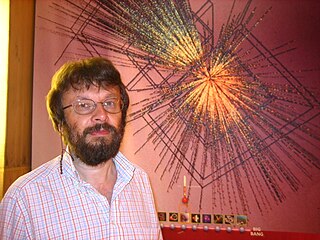
Marek Gaździcki is a Polish high-energy nuclear physicist, and the initiator and spokesperson of the NA61/SHINE experiment at the CERN Super Proton Synchrotron (SPS).

The onset of deconfinement refers to the beginning of the creation of deconfined states of strongly interacting matter produced in nucleus-nucleus collisions with increasing collision energy.
In high-energy nuclear physics, strangeness production in relativistic heavy-ion collisions is a signature and diagnostic tool of quark–gluon plasma (QGP) formation and properties. Unlike up and down quarks, from which everyday matter is made, heavier quark flavors such as strange and charm typically approach chemical equilibrium in a dynamic evolution process. QGP is an interacting localized assembly of quarks and gluons at thermal (kinetic) and not necessarily chemical (abundance) equilibrium. The word plasma signals that color charged particles are able to move in the volume occupied by the plasma. The abundance of strange quarks is formed in pair-production processes in collisions between constituents of the plasma, creating the chemical abundance equilibrium. The dominant mechanism of production involves gluons only present when matter has become a quark–gluon plasma. When quark–gluon plasma disassembles into hadrons in a breakup process, the high availability of strange antiquarks helps to produce antimatter containing multiple strange quarks, which is otherwise rarely made. Similar considerations are at present made for the heavier charm flavor, which is made at the beginning of the collision process in the first interactions and is only abundant in the high-energy environments of CERN's Large Hadron Collider.

The NA49 experiment was a particle physics experiment that investigated the properties of quark–gluon plasma. The experiment's synonym was Ions/TPC-Hadrons. It took place in the North Area of the Super Proton Synchrotron (SPS) at CERN from 1991-2002.
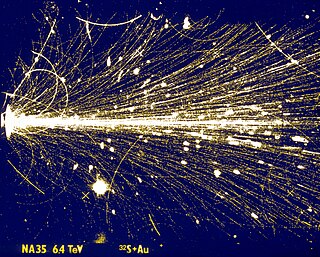
The NA35 experiment was a particle physics experiment that took place in the North Area of the Super Proton Synchrotron (SPS) at CERN. It used a streamer chamber with comprehensive hadronic and electromagnetic calorimetry. This experiment was used to observe the properties of nucleus-nucleus collisions at 60 and 200 GeV/nucleon, to understand the degree of stopping and thermalization, determine the energy densities achievable in those conditions, and to measure other related properties and quantities.
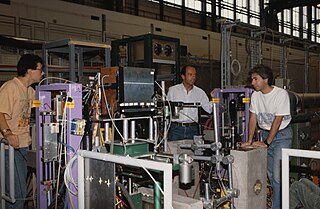
The WA89 experiment (Omega/Hyperon) was a particle physics experiment operating from 1989 to 1994 in the West Area of the SPS accelerator at CERN. It was a large acceptance forward spectrometer dedicated to the spectroscopy of charmed strange baryons and exotic multiquark states produced by a hyperon beam.

Volker D. Burkert is a German physicist, academic and researcher. He is a Principal Staff Scientist at the Thomas Jefferson National Accelerator Facility at Jefferson Lab (JLab) in Newport News, Virginia (USA). He has made major contributions to the design of the CEBAF Large Acceptance Spectrometer (CLAS) that made it suitable for high luminosity operation in experiments studying spin-polarized electron scattering.
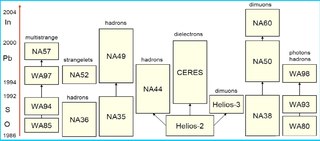
WA93 experiment was a detector experiment conducted at CERN for studying the correlations between photons and charged particles. It was an experimental program of CERN and part of the research programme SPS. The experiment was majorly conducted by the Indian High-Energy Heavy Ion Physics Team at CERN-SPS. For measurement of the multiplicity and the rapidity and azimuthal distributions of photons in ultra-relativistic heavy ion collisions, Photon Multiplicity Detector was implemented in the experiment. The experiment was led by Indian physicist Y P Viyogi. Hans H. Gutbrod was the spokesperson of the experimental project. The experimental project was approved on 22 November 1990. The experiment was completed on 9th May 2002.















